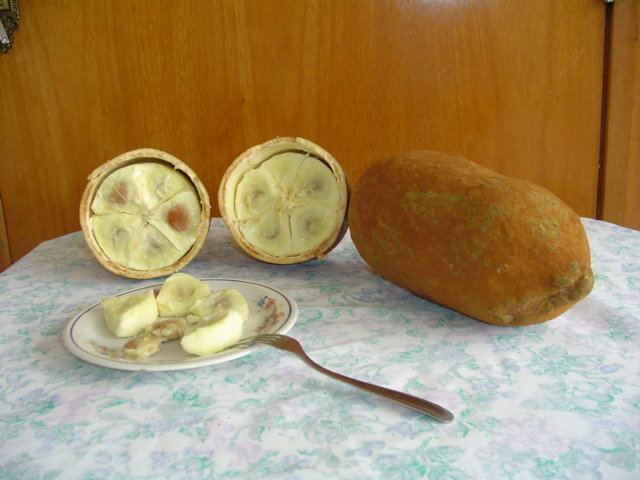Kingdom Plantae Family Malvaceae Scientific name Theobroma grandiflorum Rank Species | Order Malvales Genus Theobroma Higher classification Theobroma | |
 | ||
Similar Açaí palm, Spondias mombin, Theobroma, Soursop, Brazil nut | ||
Cupuac u fruit a whole food plant based yogurt substitute
Cupuaçu (Theobroma grandiflorum), also spelled cupuassu, cupuazú, cupu assu, and copoasu, is a tropical rainforest tree related to cacao. Common throughout the Amazon basin, it is widely cultivated in the jungles of Colombia, Bolivia and Peru and in the north of Brazil, with the largest production in Pará, followed by Amazonas, Rondônia and Acre.
Contents
- Cupuac u fruit a whole food plant based yogurt substitute
- Murumuru vs cupua u
- Fruit
- Phytochemicals
- Cupuau butter
- Ecology
- References

Cupuaçu trees usually range from 5–15 m (16–49 ft) in height, though some can reach 20 m (66 ft). They have brown bark and leaves are 25–35 cm (9.8–13.8 in) long and 6–10 cm (2.4–3.9 in) across, with 9 or 10 pairs of veins. As they mature, the leaves change from pink-tinted to green, and eventually they begin bearing fruit. Cupuaçu fruits are oblong, brown, and fuzzy, 20 cm (7.9 in) long, 1–2 kg (2.2–4.4 lb) in weight, and covered with a thick 4–7 mm (0.16–0.28 in), hard exocarp.

Murumuru vs cupua u
Fruit

The white pulp of the cupuaçu has an odour described as a mix of chocolate and pineapple and is frequently used in desserts, juices and sweets. The juice tastes primarily like a pear, with a hint of banana.
Phytochemicals
Cupuaçu flavors derive from its phytochemicals, such as tannins, glycosides, theograndins, catechins, quercetin, kaempferol and isoscutellarein.
It also contains caffeine, theobromine, and theophylline as found in cacao, although with much lower content of caffeine.
Cupuaçu butter

Cupuaçu butter is a triglyceride composed of saturated and unsaturated fatty acids, giving the butter a low melting point (approximately 30 °C) and texture of a soft solid, lending its use as a confectionery resembling white chocolate. Main fatty acid components of cupuaçu butter are stearic acid (38%), oleic acid (38%), palmitic acid (11%) and arachidic acid (7%).
Ecology
Cupuaçu supports the butterfly herbivore lagarta verde, Macrosoma tipulata (Hedylidae), which can be a serious defoliator.
